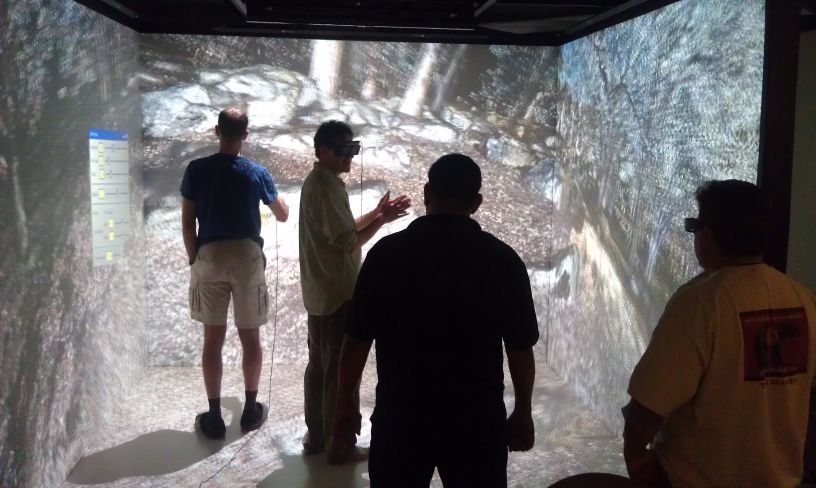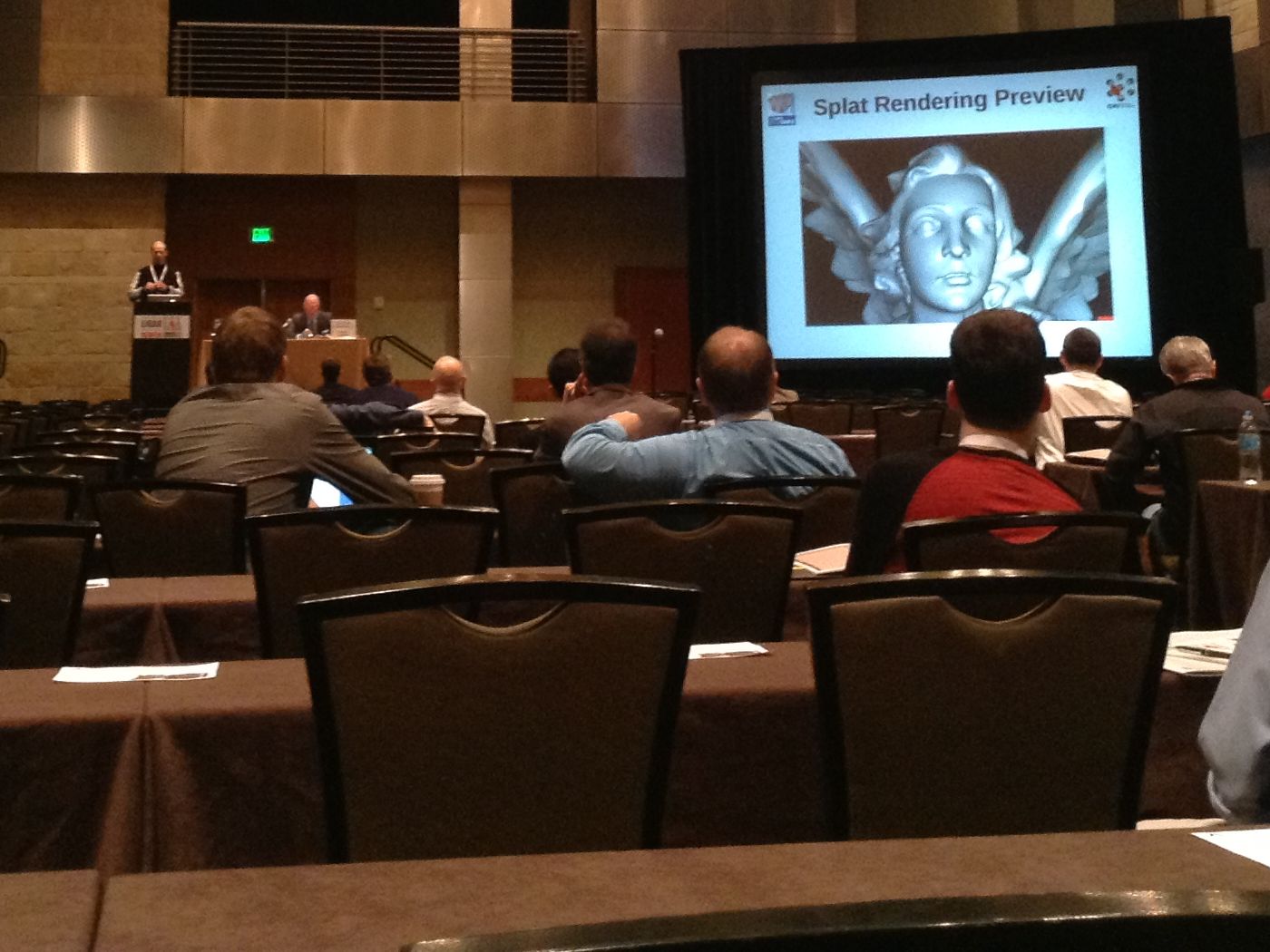I just found this old photo on one of my cameras, and it’s too good not to share. It shows former master’s student Peter Gold (now in the PhD program at UT Austin) working with a high-resolution aerial LiDAR scan of the El Mayor-Cucapah fault rupture after the April 2010 earthquake (here is the full-resolution picture, for the curious).
Category Archives: Scientific Visualization
Oh, the places you’ll go!
Hey look! A still frame of an animated visualization I created of a CAT scan of a fragment of the meteorite that landed close to Sutter’s Mill in Northern California almost a year ago made the cover of Microscopy Today. Here’s a link to the original post I wrote back in December 2012, and because it’s really pretty, and all grown up and alone out there in the world now, here is the picture in question again:
To quickly recap from my original post, the CAT scan of this meteorite fragment was taken at the UC Davis Center for Molecular and Genomic Imaging, and then handed to me for visualization by Prof. Qing-zhu Yin of the UC Davis Department of Geology. The movies I made were to go along with the publication of Qing-zhu’s and his co-authors’ paper in Science.
I thought I did a really good job with the color map, given that that’s not normally my forte. The icy blue — dark blue gradient nicely brings out the fractures in the crust, and the heavy element inclusions stand out prominently in gold (Blue and gold? UC Davis? Get it?). You can watch the full video on YouTube. I’d link to Qing-zhu’s own copy of the video, but it has cooties, I mean ads on it, eww.
And as can be seen in a full-page ad on page 31 of the same issue of Microscopy Today, apparently my picture — no doubt by virtue of the 3D meteorite fragment scan shown in it — was one of the winners in a “coolest thing you’ve never seen” contest held by the company who made the X-ray CT scanner. My little picture is Miss September 2013. Hooray, I guess?
Low-cost VR for materials science
In my ongoing series on VR’s stubborn refusal to just get on with it and croak already, here’s an update from the materials science front. Lilian Dávila, former UC Davis grad student and now professor at UC Merced, was recently featured in a three-part series about cutting-edge digital research at UC Merced, produced by the PR arm of the University of California. Here’s the 10-minute short focusing on her use of low-cost holographic displays for interactive design and analysis of nanostructures:
Of CAVEs and Curiosity: Imaging and Imagination in Collaborative Research
On Monday, 03/04/2013, Dawn Sumner, one of KeckCAVES‘ core members, gave a talk in UC Berkeley‘s Art, Technology, and Culture lecture series, together with Meredith Tromble of the San Francisco Art Institute. The talk’s title was “Of CAVEs and Curiosity: Imaging and Imagination in Collaborative Research,” and it can be viewed online (1:12:55 total length, 50 minutes talk and 25 minutes lively discussion).
While the talk is primarily about the “Dream Vortex,” an evolving virtual reality art project led by Dawn and Meredith involving KeckCAVES hardware (CAVE and low-cost VR systems) and software, Dawn also touches on several of her past and present scientific (and art!) projects with KeckCAVES, including her work on ancient microbialites, exploration of live stromatolites in ice-covered lakes in Antarctica, our previous collaboration with performing artists, and — most recently — her leadership role with NASA‘s Curiosity Mars rover mission.
The most interesting aspect of this talk, for me, was that the art project and all the software development for it, are done by the “other” part of the KeckCAVES project, the more mathematically/complex systems-aligned cluster around Jim Crutchfield of UC Davis‘ Complexity Sciences Center and his post-docs and graduate students. In practice, this means that I saw some of the software for the first time, and also heard about some problems the developers ran into that I was completely unaware of. This is interesting because it means that the Vrui VR toolkit, on which all this software is based, is maturing from a private pet project to something that’s actually being used by parties who are not directly collaborating with me.
Meet the LiDAR Viewer
I’ve recently realized that I should urgently write about LiDAR Viewer, a Vrui-based interactive visualization application for massive-scale LiDAR (Light Detection and Ranging, essentially 3D laser scanning writ large) data.

Figure 1: Photo of a user viewing, and extracting features from, an aerial LiDAR scan of the Cosumnes River area in central California in a CAVE.
I’ve also realized, after going to the ILMF ’13 meeting, that I need to make a new video about LiDAR Viewer, demonstrating the rendering capabilities of the current and upcoming versions. This occurred to me when the movie I showed during my talk had a copyright notice from 2006(!) on it.
Immersive visualization for archaeological site preservation
Have I mentioned lately that VR is not dead yet, and instead thinks it’ll be going for a walk? Here’s more proof. One of KeckCAVES‘ external users, Marshall Millett, archaeologist and GIS expert, is using high-resolution 3D scanning, based on LiDAR or white-light scanning, to capture and digitally preserve cultural heritage sites, such as the Maidu Indian Museum’s historic site and trail (close to Roseville, CA).

Figure 1: Danny Rey, Tribal Historic Preservation Officer, and Marcos Guerrero, Cultural Resources Manager, representatives of the United Auburn Indian Community, viewing a high-resolution 3D scan of the Maidu Historic Trail and Site in the KeckCAVES immersive visualization facility. In the background Joe Dumit of UC Davis’ Science and Technology Studies, and myself. Photo provided by Marshall Millett.
Marshall has been using KeckCAVES software, particularly LiDAR Viewer (about which I should really write a post), and also the KeckCAVES facility itself and related technology, to visualize his high-resolution 3D models at 1:1 scale, and with the ability to experience them in ways that are not normally possible (most of these sites are fragile and/or sacred, and not available to the public). Part of this work were several visits of community representatives to the KeckCAVES facility, to view their digitally reconstructed historic site (see Figure 1).
Marshall presented a poster about his work at last year’s 3D Digital Documentation Summit, held July 10-12, 2012 at the Presidio, San Fransisco, CA, and was just interviewed for a podcast by the National Center for Preservation Technology and Training (where, as of 02/21/2013, KeckCAVES prominently features on the front page).
On the road for VR (sort of…): ILMF ’13, Denver, CO
I just returned from the 2013 International LiDAR Mapping Forum (ILMF ’13), where I gave a talk about LiDAR Viewer (which I haven’t previously written about here, but I really should). ILMF is primarily an event for industry exhibitors and LiDAR users from government agencies or private companies to meet. I only saw one other person from the academic LiDAR community there, and my talk stuck out like a sore thumb, too (see Figure 1).
Is VR dead?
No, and it doesn’t even smell funny.
But let’s back up a bit. When it comes to VR, there are three prevalent opinions:
- It’s a dead technology. It had its day in the early nineties, and there hasn’t been anything new since. After all, the CAVE was invented in ’91 and is basically still the same, and head-mounted displays have been around even longer.
- It hasn’t been born yet. But maybe if we wait 10 more years, and there are some significant breakthroughs in display and computer technology, it might become interesting or feasible.
- It’s fringe technology. Some weirdos keep picking at it, but it hasn’t ever led to anything interesting or useful, and never will.
KeckCAVES on Mars, pt. 3
Yesterday, Wednesday, 01/09/2013, Michael Meyer, the lead scientist on NASA’s Mars exploration mission, which includes the ongoing Curiosity rover mission, visited UC Davis as a guest of Dawn Sumner‘s, the KeckCAVES scientist working on that same mission. Dr. Meyer held a seminar in the Geology department, and also gave an interview to one of our local newspapers, the Sacramento Bee.
As part of this visit, Dawn showed him the CAVE, and the Mars-related visualization work we have been doing, including Crusta Mars and our preliminary work with a highly detailed 3D model of the Curiosity rover.
I’m still on vacation, so I missed the visit. Bummer. 🙁
Downloading earthquake datasets for ShowEarthModel
ShowEarthModel is one of the example programs shipped with the Vrui VR development toolkit. It draws a simple texture-mapped virtual globe, and can be used to visualize global geophysical data sets — specifically those containing subsurface data, as the globe can be drawn transparently. However, ShowEarthModel is not packaged with any data sets, primarily to keep the download size small, but also for licensing reasons. Out of the box, it only contains a fairly low-resolution color-mapped Earth topography texture (which can be changed, but that’s a topic for another post).
Since it’s one of the most common requests, here are the steps to download up-to-date earthquake data from the ANSS online catalog:




